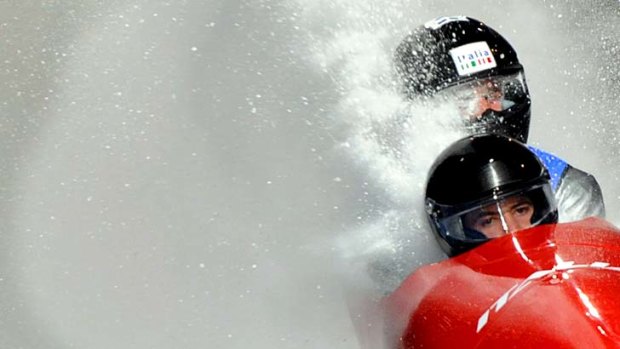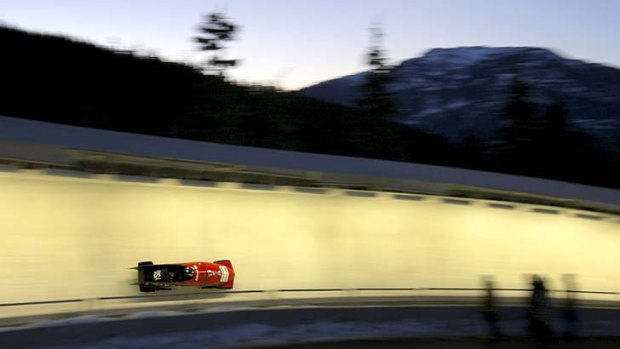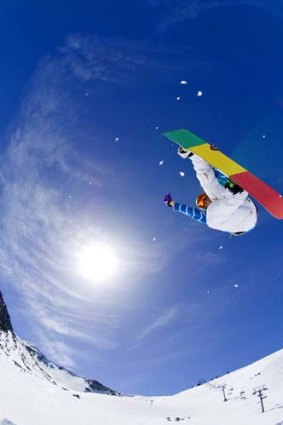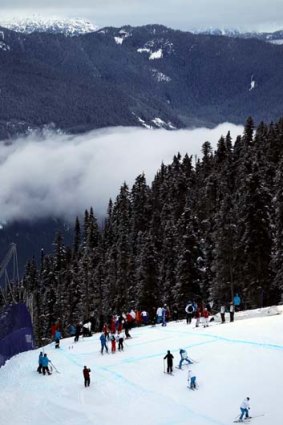
White-knuckles ... Olympic racing in bobsleigh.Credit: Getty Images
Ben Groundwater risks life and limb in his own personal version of the Winter Olympics.
This has to be a joke. Someone's having a laugh. It's as if blasting down an ice slide at 125km/h wasn't frightening enough. As if pulling 3½ Gs in a small metal box wasn't sufficiently insane.
Now we're being told about the guy in charge, the one in whose hands our fragile little lives are being placed.

A bobsleigh hurtles around the track.Credit: Getty Images
"Oh, Pat's a pro, eh?" says one of the bobsleigh instructors. "He used to be the coach of the Jamaican bobsleigh team. You know the movie Cool Runnings? That's your man."
Right. So that'll be the John Candy character, the one who was disgraced after being caught cheating? The one who coached the team that became a perennial punchline? The team that seemed to spend most of the movie upside down? That one?
Australia, we have a bobsleigh team. OK, I'm not representing Australia proper. But I am Australian and I'm now officially part of a bobsleigh team. And my driver is that guy from Cool Runnings.
You haven't seen steep until you've seen this thing.
His name's Pat Brown and the truth, he reckons, is much plainer than fiction. "That movie was mostly bullshit," he laughs as he clamps a helmet on his head, dusts some snow off his visor and eases himself into the front seat of our bobsleigh, which is poised to dive into the entry of the Olympic track in Whistler, Canada.
We grip the bars on the sledge's side, hunching our shoulders to wedge our helmeted heads into place. Pause for a few deep breaths. In a couple of seconds we'll be given a push, slide on to the first icy pitch and within 43 seconds we'll have completed an experience that few but the most elite Olympic athletes could ever boast of having had.
It doesn't seem real. To someone who's grown up in sunny Australia, the Winter Olympics have only ever been an abstract concept, an oddity of bizarre pastimes that appears on our TV screens every four years.

A snowboarder in one of the terrain parks.Credit: Getty Images
Luge? Freestyle skiing? Speed skating? Most sports at the Winter Olympics seem about as useful in the real world as algebra. Have you watched curling? It's ridiculous.
But the Winter Olympics are a fun novelty and there are always lots of crashes to keep casual viewers amused - it's a little like that show Wipeout, only with a medal ceremony at the end.
In Whistler, however, a place that has long been a playground for Australia's hardcore snow fanciers and which played host to the 2010 Games, the Olympics have come to life. You, Average Joe Punter, now have the opportunity to try your hand at some of the most peculiar and thrilling winter sports on the planet.

Whistler's ski slopes.Credit: Getty Imagtes
Bobsleigh is one of them. Skeleton, another. Then there's biathlon, plus snowboarding like a pro in the mountain's two terrain parks, and taking on an Olympic downhill skiing run. Bring it on.
First up: bobsleigh - at the real Olympic track, wedged into a small part of the mountain on the Blackcomb side. Scary? A little bit.
The run itself will take a tick more than 40 seconds. The safety briefing goes for two hours. One wrong move by our driver, one flick of the steering pedal at the wrong moment, and we'll be flipped upside down, left to careen out of control down the icy track on our faces.
We're being given a virtual tour of the track in the briefing centre, having it all explained corner by corner, when the Vancouver real estate agent sitting next to me leans over and points to the huge final bend. "That's where the guy died in the Olympics," he whispers helpfully, referring to Nodar Kumaritashvili, the Georgian luge racer who met a tragic end during a training run back in 2010.
Great. We're not, however, doing the entire track, just the bottom two-thirds, meaning we won't quite hit the speeds they did in the Olympics. We're also going down in a modified, safer bobsleigh, and the Whistler staff are at pains to point out that nothing has ever gone wrong for the Average Joes here.
After our two hours of briefing we finally trudge out into the snow, load up in a van and drive to the top of the track where our bright-red chariot awaits. The snow's coming down hard as the call goes out across the loudspeaker system: "The track is now clear."
Show time. There are three of us Average Joes aboard; we strap our helmets on, give each other a little nervous high-five and climb one by one into the bobsleigh, wrapping legs around each other to get a tight fit.
Finally, from a heated cabin emerges former Jamaican bobsleigh coach Brown in his racing jumpsuit, taking his place at the front of the sledge, doing a quick test of the steering. There's an eerie quiet in your helmet as the visor comes down, a sort of calm before the storm as a countdown is suddenly screamed out.
"Three! Two! One! Go!"
We're rolling. Slowly at first, until we swoop onto the track proper and start rapidly gaining speed. The sledge is grinding on the ice in a roar now as the G-forces take hold and we belt through corner after corner, faster and faster as we go, the track walls just a blur as we carve into the final killer turn, the Thunderbird, hitting three Gs that force our bodies down into the sledge, rattling and shaking, before we finally hit the uphill run-off and start to lose our speed.
Forty-three seconds - that's all it took. We hit 125km/h in that little metal box and Pat, of course, was up to the job of keeping us safe.
Your legs are wobbly with adrenalin after something like that, although Pat looks calm and collected, ready for his next group. Maybe that movie was all garbage. And anyway, where's the medal dais?
But the Winter Olympics aren't over. There's more to come. No time for biathlon, unfortunately, although the combination of cross-country skiing and shooting does sound at least 50 per cent enjoyable. Skeleton is off the menu as well, because there are too many eager Aussies already preparing themselves for a face-first hurtle down the very track I've just negotiated with Pat's help.
Instead it's off to the Dave Murray Downhill, the slope used for the men's ski racing at the Vancouver Games.
You haven't seen steep until you've seen this thing. It drops nearly one vertical kilometre in 3.2 kilometres of ski run. It's the kind of slope you want to carefully negotiate with about 200 turns, not point your skis down, tuck and go.
We have a guide for this run, a former professional ski racer who not only negotiated it at full tilt during the Olympics, but did it with a video camera in his hands so television viewers at home could get a feel for what the athletes were going through.
His name's Peter Smart, a Whistler local who counts breaking five vertebrae as a "pretty bad fall" and who clearly has little regard for his own personal safety. Which makes him the perfect guide.
"So the skiers will typically be hitting about 130km/h through here," Peter says, pulling to a halt on a particularly steep section towards the middle of the run, before shaking his head. "I saw some gnarly crashes right here, dude; gnarly."
Then Peter's off again, barrelling through a flat section called the "Toilet Bowl", so named because "it forces people to sit back hard on their skis, making it look like - you know". We cruise down through more sickeningly steep sections, where skiers would shoot 30-40 metres through the air after hitting the tiniest lumps during the Olympic Games.
Just for good measure, Peter finishes his tour with a trip through the terrain park, another legacy of the Olympic competition, taking a few of the huge jumps at light speed while the rest of us just watch on in slight awe.
It helps to put things in perspective. The Winter Olympics might seem a fun oddity to those of us watching it on TV in our tropical homes, as it surely must have once done to that Jamaican bobsleigh team. But here in Whistler, trying your hand at the real deal, it suddenly makes sense.
The writer travelled as a guest of Whistler and the Canadian Tourism Commission.
Three ways to take it easy in Whistler
1 Scandinave Spa This ridiculously large spa complex set in the middle of the forest has outdoor hot tubs, saunas, steam baths, "Nordic waterfalls", hammocks, indoor lounges and a cafe — in other words, all the things you need after throwing yourself down a mountain all day.
2 Tube Park If it's gentle, mindless fun you're after, the Whistler Tube Park might be the way to go. It's easy: take the conveyor belt to the top, position your tube at the top of a lane, get in and go. No skill (or thought) required.
3 Alta Bistro Another activity good for aching bones is simply sitting down and eating. Alta is one of Whistler's top restaurants, with a focus on locally sourced, sustainable ingredients. Fortunately it tastes good, too.
Trip notes
Getting there
Air Canada flies direct to Vancouver from Sydney. 1300 655 767, aircanada.com. Pacific Coach Lines has transfers from Vancouver Airport to Whistler. www.pacificcoach.com.
Staying there
Nita Lake Lodge has double rooms in Whistler Creekside starting from $C197.45 ($194) a night. nitalakelodge.com.
Activities
The bobsleigh and skeleton are done through the Whistler Sliding Centre. Bobsleigh and skeleton rides cost $C149. The Dave Murray Downhill is accessible with a regular Whistler Blackcomb lift pass, which costs $C96. Peter Smart's ski school, Extremely Canadian, charges from $C539 for full-day, custom skiing clinics. extremelycanadian.com.
More information
Sign up for the Traveller Deals newsletter
Get exclusive travel deals delivered straight to your inbox. Sign up now.